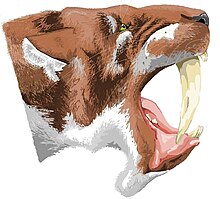Barbourofelis
| Barbourofelis | |
|---|---|

| |
| B. loveorum, Florida Museum of Natural History Fossil Hall at the University of Florida | |
| Scientific classification | |
| Domain: | Eukaryota |
| Kingdom: | Animalia |
| Phylum: | Chordata |
| Class: | Mammalia |
| Order: | Carnivora |
| Suborder: | Feliformia |
| Family: | †Barbourofelidae |
| Tribe: | †Barbourofelini |
| Genus: | †Barbourofelis Schultz, Schultz & Martin, 1970 |
| Type species | |
| †Barbourofelis fricki Schultz, Schultz & Martin, 1970
| |
| Other Species | |
| |
Barbourofelis is an extinct genus of large, predatory,
Taxonomy
Barbourofelis was named by Bertrand Schultz, Marian Schultz, and Larry Martin in 1970 in honor of Erwin Hinckley Barbour, who died a few days before the holotype was discovered.[3] Its type is Barbourofelis fricki and is the type genus of the subfamily Barbourofelinae.
Description


While the species B. fricki is thought to have been a
The most extensive selections of bones found for this genus come from B. loveorum and have allowed further inference to the proportions of other members of the genus.[4]
Paleobiology
Growth and development

The skeletons of juvenile Barbourofelis have been found, and examination of their skeletons indicates that the cubs would reach near-adult size before their milk sabers would begin to erupt. This indicates that they were dependent on their mother or potential family group until well into their second year. Such a long period of dependence would have likely led to situations in which near-adult cubs would have likely helped to restrain prey while their mother made the kill. Such behavior potentially was a foundation for more extensive social ties in later feliforms and felids.[4]
Paleoecology
Barbourofelis loveorum's environment in the
References
- S2CID 84817087.
- ^ Barbourofelis in the Paleobiology Database
- ^ Schultz, C. Bertrand; Schultz, Marian R.; Martin, Larry D. (October 1970). "A New Tribe of Saber-toothed Cats (Barbourofelini) from the Pliocene of North America" (PDF). Bulletin of the University of Nebraska State Museum. 9 (1).
- ^ ISBN 9780253010421.
- ISBN 9780253010421.
- ISBN 9780253010421.
- ISBN 0-231-10228-3.
